Looking at Prehistory:
Indiana's Hoosier National Forest Region, 12,000 B.C. to 1650
|

|
Looking at Prehistory:
Late Woodland Period ca. A.D. 500 to 1500
Perhaps two of the most significant occurrences that
mark the Late Woodland period are the appearance and wide-spread use of
the bow and arrow and an emphasis on growing domesticated crops and
other cultigens along with collecting wild plant foods. There is more of
a sedentary lifestyle associated with agriculture, but that does not
explain why the high ceremonialism of Hopewell comes to an end during
the Late Woodland period. A number of distinctive variations in Late
Woodland ceramics are diagnostic of the cultures or social groups they
represent, but they all include some type of stone or clay tempering.
The ceramics, along with other cultural traits, clearly separates them
from Mississippian cultures that used shell
tempering in their ceramic technology. Jack's Reef cluster (early)
and unnotched triangular points (late) become widespread
during the Late Woodland period (Figure 83). The former emphasis on the
Wyandotte chert source for tools greatly diminishes in favor of local
sources of chert. Some agricultural implements appear, along with many
kinds of cultivated foods and eventually varieties of corn, beans, and
squashes are developed and grown intensively at Mississippian sites.
There is also evidence for the increased use and size of storage pits to
preserve foods for the winter months. A number of Late Woodland phases
are known, including Oliver, Albee, Newtown, and Yankeetown. Oliver
phase and Yankeetown pottery have been identified
at camps within the hill country of the Hoosier
National Forest.
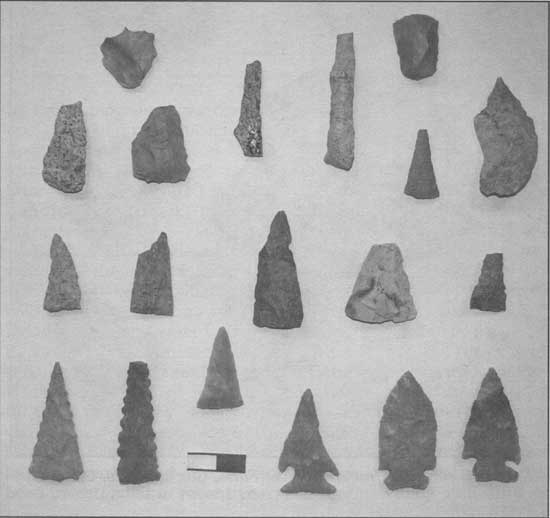
|
|
Figure 83: Arrow point variations, drills, end
scrapers, and gravers. These include Jacks Reef cluster and triangular
types from Oliver phase and other southern Indiana sites.
|
The Oliver phase people borrowed traits from Fort
Ancient tradition people who occupied southeastern Indiana, southern
Ohio, and northern Kentucky and also Springwells cultural manifestations
that extended into Indiana from the western side of Lake Erie (Figure
84). The Oliver phase is dated from A.D. 1000 to perhaps as late as
1400, overlapping with the Mississippian occupation of southern
Indiana.

|
|
Figure 84: Oliver phase decorated ceramics from the
Oliver Farm, Cox's Woods, Clampitt, and Bowen sites.
|
The Cox's Woods site was occupied by Oliver phase
families who built a double-walled earthen enclosure to encircle the
site and had a number of houses in a ring around a central plaza or community
area. The site is located near the Pioneer Mothers Memorial Forest on
Hoosier National Forest property, protecting one of the few remaining
stands of primary forest left in Indiana (Figure 85). Middens of refuse
accumulated within the enclosure and the surrounding area from the
remains of thousands of meals eaten by people living at the site over an
extended period of time. Excavations documented many post-molds, marked
by circular stains, following patterns indicating the locations of the
houses and also storage pits, hearths, and rock concentrations
containing artifacts such as pottery (Figures 86-87). Food remains
collected by archaeologists show corn agriculture was combined
with collected fruits, nuts and seeds and that there were significant
amounts of maygrass and little barley cultivated along with the hunting
of deer, elk, turkey and other animals.
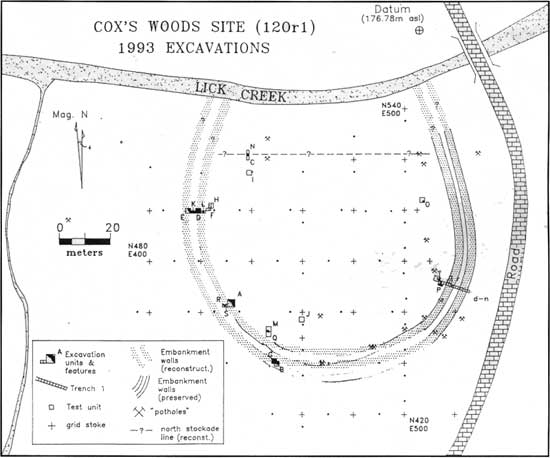
|
|
Figure 85: The plan of the Cox's Woods site determined by limited
test excavations over selected segments of the site. Indiana University
field school, 1993.
|
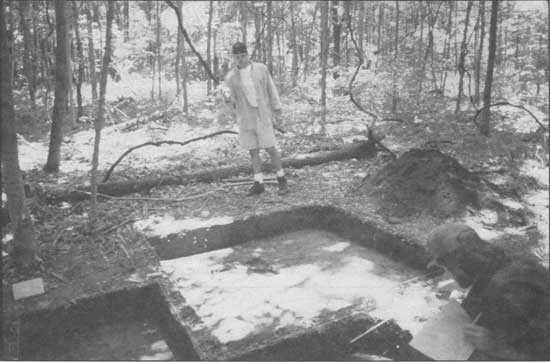
|
|
Figure 86: Ongoing excavations at the Cox's Woods site. Indiana
University field school, 1993.
|
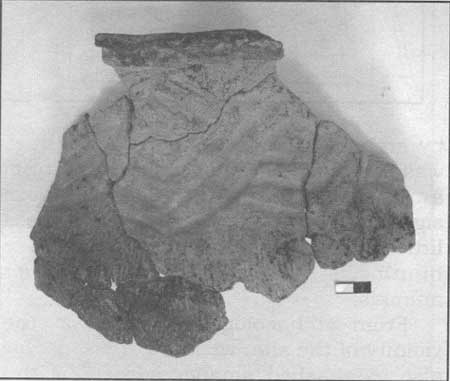
|
|
Figure 87 (right): Rim of reconstructed ceramic vessel excavated
from the Cox's Woods site.
|
From archaeological surveys in the vicinity of the
site, we know these people also established smaller gardening and
collecting camps away from Cox's Woods. This settlement was established
in a remote location some distance from the floodplain of the East Fork
of the White River and it is suspected that future studies may show
Oliver phase village sites in other areas of the Hoosier National
Forest. Oliver phase villages located nearby and further north have been
investigated in recent years, adding
greatly to our knowledge about these people (Figures
88-90). The presence of Half Moon Spring could have been a factor in the
location of the Cox's Woods site, where the people could have extracted
salt crystals from the saline waters at the spring for cooking, the
preservation of meat and hides, as well as exchange (Figure 91).
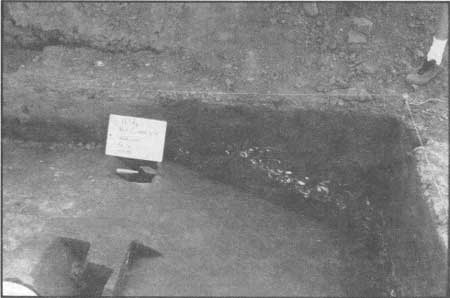
|
|
Figure 88: A profile of an Oliver phase village in Morgan County
showing a deposit of discarded mussel shells over an old swale in the
White River floodplain. Indiana University field school, 1995.
|
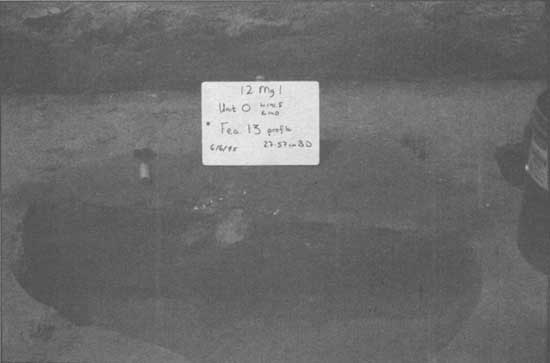
|
|
Figure 89: The profile of a large Oliver phase pit
feature with artifacts and refuse and food remains. Indiana University
field school, 1995.
|

|
|
Figure 90: A large area of pit features exposed and ready for mapping at
an Oliver phase site in Johnson County. Indiana University field school,
1995.
|
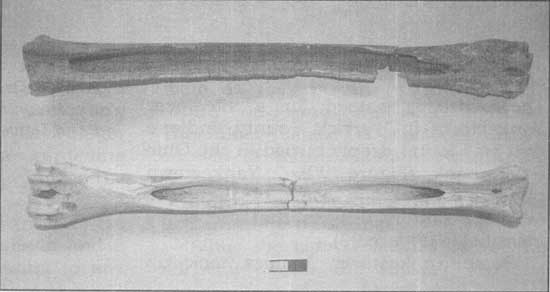
|
|
Figure 91: Deer bone "beamers" for removing the hair from animal skins
from the Oliver phase Clampitt and Bowen sites.
|
Yankeetown phase people lived within an area
encompassing the lower Ohio River Valley from southern Illinois and
nearby Kentucky, the lower Wabash Valley and into south-central
Indiana The phase is named for a site near Yankeetown in
Warrick County, Indiana that was found deeply buried in the Ohio River
bank (Figure 92). Yankeetown phase people made some of the more
aesthetic pottery designs that are easily identifiable (Figure 93).
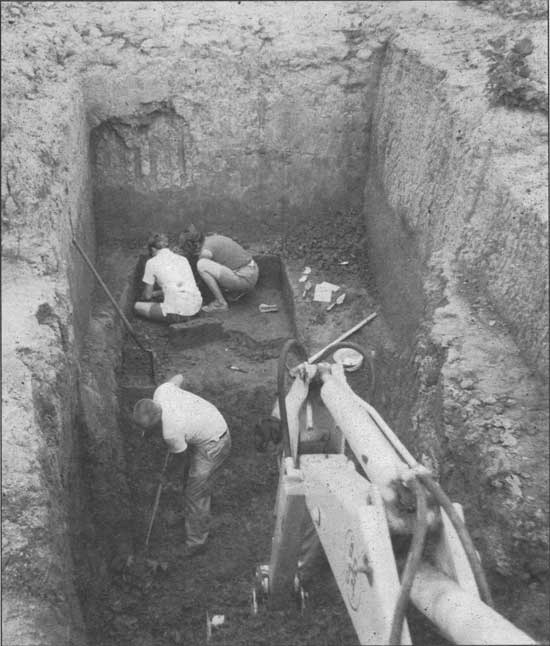
|
|
Figure 92: Deep test excavations at the
Yankeetown site, Warrick County, IN by Indiana University in 1967.
|
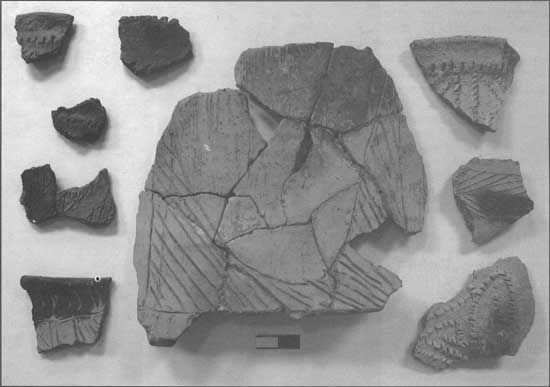
|
|
Figure 93: Yankeetown phase ceramics from the Yankeetown site and
Rockhouse Hollow Shelter (upper left).
|
Some Yankeetown families took up residence at Rockhouse Hollow
shelter for a limited time around A.D. 900-1000. We know this
because they left fragments of their distinctive ceramic vessels in the
shelter. There are likely to be more sites found in the future within
the Hoosier National Forest that were occupied by Yankeetown peoples.
One suspects, however, the main use of the hill country by people of the
Yankeetown phase may have been in the form of limited hunting and
collecting camps in a variety of settings, including rockshelters and
open sites. Their larger base settlements and summer gardening camps
were established along the floodplain of the Ohio River.
The other Late Woodland groups were dispersed across
central Indiana and a wider area that did not expand to any
degree into south-central Indiana. One large rim
sherd that was found in excavations within Arrowhead Arch in Crawford
County may be significant (Figures 94-95). It can be attributed to
either Oliver phase people from the north, or Fort Ancient, Anderson
phase people coming from the east near Cincinnati. This is another
example of limited use by perhaps single families that probably carried
the pottery with them as they moved up into the hill country on hunting
and collecting trips. The Albee phase is not well-known outside of
central Indiana, within the Wabash and White River drainages. The
Newtown phase is apparently restricted to southeastern Indiana.
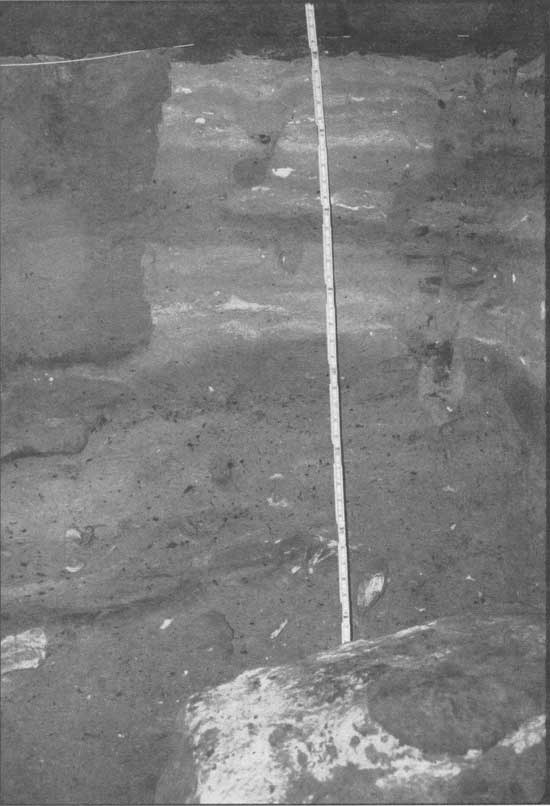
|
|
Figure 94: A profile of the deposits during
excavations at Arrowhead Arch by Indiana University in 1984. Note the
changes in soil color and consistency marking differences in the human
use of the site. The light color of the upper part is due to overlapping
ash lenses with rodent burrows. The dark area on the left marks a
looter's pit that destroyed valuable information about the sites
history.
|
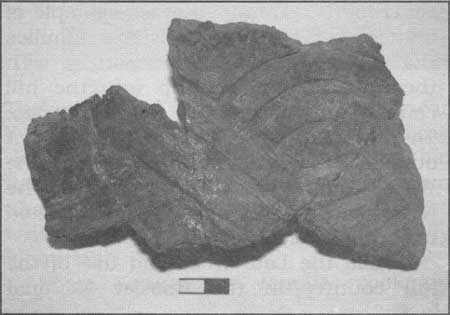
|
|
Figure 95: A reconstructed portion of a ceramic vessel recovered from
Arrowhead Arch.
|
While the Late Woodland use of the hill country in
the Hoosier National Forest may appear to be limited
compared to other prehistoric time periods, we must consider that much
is still unknown and remains to be documented. Thus, it is imperative
that interested persons, avocational archaeologists and professionals
collaborate to record information about the archaeology of the wider
region. A major effort has been underway in recent years to investigate
the many Late Woodland and other cultures that left their remains in
Indiana. Laypersons can help save important sites and information about
the prehistory of southern Indiana by reporting acts of looting and
vandalism and notifying authorities about the existence of
archaeological sites. Archaeologists rely on the good faith efforts of
the public to tell them about local discoveries so that the information
can help clarify what we know about the settlement systems of
prehistoric peoples in the Late Woodland period of the hill country and
the many cultures that came before and after this time.
While there is a temporal overlap between Late
Woodland cultures and those of the Mississippian period, many
Mississippian traits, including village organization, mound building,
trade and ceremonial habits are substantially different. Long before
Mississippian period cultures expanded north from the southeastern
United States however, many Late Woodland period cultures had evolved
from the local Middle Woodland cultures and were dispersed throughout much
of the Northeast Great Lakes, and Ohio Valley. We now know that Late
Woodland groups continued to occupy a number of areas in Indiana
throughout the following Mississippian period, and there appears to have
been interaction on a number of fronts between Late Woodland and
Mississippian groups, though each apparently retained their own cultural
identity. There is evidence at Cahokia in Illinois and other
Mississippian centers that groups with traditional Late Woodland
cultural affiliation were sometimes incorporated into Mississippian
society. One must also consider that such factors as politics,
economics, and warfare presented a dynamic situation involving groups
being incorporated and later splitting into smaller communities to live
again as they once did. Groups splitting away from a major town center
could have populated a new area or, when possible, could have returned
to an ancestral home their parents and grandparents kept alive in
stories of former times. This ebb and flow of cultural associations and
population movements probably also took place in Indiana. For
archaeologists, the specific details of cultural dynamics are difficult
to pin down because of the addition and mixing of artifacts and traits
at some archaeological sites that belong to several cultural traditions
and bridge two archaeological time periods.
9/hoosier/prehistory/sec7.htm
Last Updated: 21-Nov-2008 |
|













